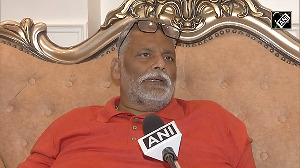The National Disaster Management Authority team will tour the earthquake-affected areas of Jammu & Kashmir soon, an NDMA member said on Sunday night.
NDMA member and Congress legislator Marri Shashidhar Reddy told rediff.com on Sunday night that the NDMA, which has been constituted recently under an executive order pending the enactment of National Disaster Management Bill by the Parliament, would hold its first meeting towards this month-end.
The NDMA is chaired by Prime Minister Dr Manmohan Singh. Retired chief of staff of the Indian Army General N C Vij is the vice-chairman.
Shashidhar Reddy said the NDMA will set up a National Disaster Response Force NDRF, comprising 8,000 specially trained personnel of the central paramilitary forces, for undertaking rescue and relief operations in times of natural calamities and other disasters.
The National Disaster Management Bill 2005, a brainchild of Congress President and Chairperson, National Advisory Council Sonia Gandhi, has been introduced in Parliament in March this year to provide for requisite institutional mechanism for drawing up and monitoring the implementation of the National Disaster Management Plan," Shashidhar Reddy explained.
The NDMA will lay down plans and policies for disaster management and approve the national disaster management plans. The NDMA will be assisted by a National Executive Committee comprising secretaries of ministries/departments such as agriculture, atomic
energy, defence, water resources, environment and forests, finance, health, power, rural development, science and technology, space, telecommunications etc, besides the chief of the integrated defence staff.
The MDMA would be responsible for drawing up the disaster management plan, coordinating and monitoring its implementation. "It will ensure measures by various wings of the government for prevention and mitigating the effects of disasters and for undertaking a holistic, coordinated and prompt response to any natural or man-made disasters," the NDMA member pointed out.
The NDMA will provide support to other countries affected by major disasters at the behest of the Government of India.
Under the National Disaster Management Bill, states will be asked to establish state disaster authorities under the chairmanship of the chief minister and district disaster management authorities headed by the district magistrates (collectors).
Andhra Pradesh, Tamil Nadu, Orissa, West Bengal, Bihar, Gujarat, Maharastra and the northeastern states have been identified as disaster-prone regions. The NDMA would undertake a tour of Tamil Nadu and Andhra Pradesh which were hit by Tsunami in December last, besides Mumbai which had witnessed over 100 cm rainfall on a single day recently.
The NDMA would seek to integrate disaster management with development plans. "Given the high frequency with which one or the other part of the country suffers due
to disasters, mitigating the impact of disasters must form an integral component of our development planning and poverty reduction strategy," Shashidhar Reddy said.
"The impact of major disasters cannot be mitigated by the provision of immediate relief alone, which is the primary focus of calamity relief efforts. Disasters can have devastating effects on the economy; they cause huge human and economic losses and can cause a serious setback to development efforts of a region or a state. There is, thus, a need to look at disasters from development perspective as well," he felt.
"Many parts of the Indian sub-continent are susceptible to different types of disasters owing to the unique topographic and climatic characteristics. Floods and high winds account for 60 percent of all disasters in India. Almost 54 percent of the sub-continent's land mss is vulnerable to earthquakes.
"About 10 crore acres of farmlands are vulnerable to periodic floods. India has a 8,000 km coastline prone to cyclones. 68 percent of the total geographical area is vulnerable to droughts," he pointed out.
During the decade 1990-2000, the country suffered very high losses due to natural calamities. The super-cyclone in Orissa in 1999 and the Gujarat earthquake in 2001 caused losses worth several thousand crores of rupees. The total expenditure on relief and reconstruction in Gujarat alone had been to the extent of Rs 11,500 crore, he added.





